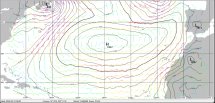Cassini Blog #124 - Weather and routing

Cassini's blog
Simon and Sally, Nigel and Catherine
Tue 7 May 2024 16:36
|
How do you get from Antigua to the Azores across over
2,000 miles of sea only using wind power? With great
difficulty is the answer!
When it comes to weather forecasting we all know it is
not an exact science. Lots of data is used in various computer models to try and
predict what is going to happen next, usually based on historical data and past
trends. While the modeling and computer power is getting better, it is still
somewhat of an art, as well as a science, and is open to interpretation. It is
also worthy of note that the further ahead you try to predict the less accurate
your forecast will be. I usually say that anything beyond 3 days is educated
guesswork! (See below for one of the weather charts we use).
With that in mind, how do you predict the wind you are
going to get on a 2,000 mile passage that will take at least two weeks? You
can't is the answer, but you can base your decisions on the next 3 days
of data and a good knowledge of the historical trends within the region.
Most East to West passages across the Atlantic take advantage of the North
Easterly trade winds coming down from Iberia and then becoming Easterly
when you get into the lower latitudes. These are very consistent and predictable
even if the strength can vary.
The passage from West to East is a bit more
unpredictable as you are dealing with a number of established weather
systems and the vagaries of the position of the jet stream.
The usual advice is to head North towards
Bermuda using the prevailing Easterly wind in the Caribbean until you can
either pick up the Westerly winds from the top of the Azores high or the South
Westerly winds from any number of Atlantic depressions travelling from the USA
to Europe. We saw on opportunity to do this on 30 April and so set off from
Antigua with confidence.
As predicted the first three days went to plan. Although
a little bumpy, as we were beating into wind, we made good progress North. then
the educated guesswork came into play and we were dogged by an area of high
pressure with very little wind. We decided to head North under engine to try and
get clear of the Horse latitudes, as they are called (20 - 30 degrees), which
are renowned for this light wind weather. We made good progress but we only have
so much fuel, and certainly not enough to get to the Azores, so when some wind
came along we took it and shut the engine down.
All the advice on planning this passage says that you
will inevitably come across some calm patches and so extra fuel is highly
recommended. We have 235 litres in our main fuel tank, enough for just about two
days running. We took heed of the advice and have 8 x 20 litre jerry cans of
fuel on the deck , giving us another day and a half. We hope this is going to be
enough!
A period of good progress was made, but more Easterly
than Northerly so still not getting us above the Horse Latitudes. However, you
take what you can get, and for a time we were making ground towards the target,
Horta. The wind has now died again and we face another run North under engine.
Hopefully we can now get above the large high (see below) that is establishing
itself over the central Atlantic and take advantage of the Westerly winds on its
North West side.
We will get to Horta eventually, it just might take
longer than we had hoped!
As we were becalmed and a boost to morale was required
we indulged in the age old tradition of "Hands to Bathe". With the nearest land
630 miles away and the sea bed 4,000 metres down, you really were swimming in
the middle of nowhere!
We will of course have another laundry day as well.
Nigel the Navigator
|
